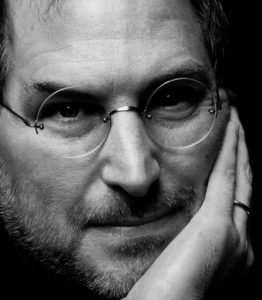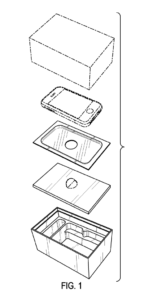Steve Jobs: Think Different, Think About the Box
May 23rd, 2018 by William Reid | Patent Trends & Activity | Recent News & Articles |
 I recently purchased some bathroom lighting from a Big Box store, confident in my ability to perform the necessary carpentry and electrical work to install it myself. I had to wait 10 or 15 minutes while an associate that I estimated at about 19, unenthusiastically pulled a huge ladder up to carry the lighting down from the top-stock shelf. Underneath the dust, the outside of the box was a glossy image of the lighting. Inside, the frame and glass were packed within an interlocking maze of cardboard, Styrofoam, plastic and tape. As an engineer, I could appreciate the thoughtfulness and competence of the design, but this admiration did not attach itself to the lighting itself, which my wife hated the second it was out of the box. It also didn’t result in any positive feeling for the packaging. In fact, the only two things the packaging inspired were anxiety over deciding which tool (box cutter, scissors, crowbar…..) would allow me to remove the lighting from the box most quickly without breaking it, and frustration from my utter defeat when I tried to put the whole thing back together before returning it to the store.
I recently purchased some bathroom lighting from a Big Box store, confident in my ability to perform the necessary carpentry and electrical work to install it myself. I had to wait 10 or 15 minutes while an associate that I estimated at about 19, unenthusiastically pulled a huge ladder up to carry the lighting down from the top-stock shelf. Underneath the dust, the outside of the box was a glossy image of the lighting. Inside, the frame and glass were packed within an interlocking maze of cardboard, Styrofoam, plastic and tape. As an engineer, I could appreciate the thoughtfulness and competence of the design, but this admiration did not attach itself to the lighting itself, which my wife hated the second it was out of the box. It also didn’t result in any positive feeling for the packaging. In fact, the only two things the packaging inspired were anxiety over deciding which tool (box cutter, scissors, crowbar…..) would allow me to remove the lighting from the box most quickly without breaking it, and frustration from my utter defeat when I tried to put the whole thing back together before returning it to the store.
For most things that we purchase, I suspect the packaging is designed primarily with a focus on its function and the associated engineering; so much so that when you encounter an item with carefully designed packaging, it stands out. For example, the packaging of fine jewelry is often designed in such a way that accessing the jewelry through the packaging amounts to a pleasant prelude, which augments the experience of actually viewing the jewelry.
In the world of electronics, no one has appreciated and successfully employed the importance of the integration of packaging design and engineering, like Apple. Everyone in the field of intellectual property are aware of the considerable number of utility patents owned by Apple. What they may not be as familiar with is their activity in the area of design patents. As described in the Steve Jobs biography by Walter Isaacson, this has been due in large part to the relationship between designer, Jonathan Ive, and the brilliant Steve Jobs. The book points out that in contrast to the typical engineering-driven design of products in most companies, at Apple, product and packaging design involves an iterative conversation between the designers and engineers to find elegant simplicity:
“Design is the fundamental soul of a man-made creation that ends up expressing itself in successive outer layers.”
As a result, the process of designing a product at Apple was integrally related to how it would be engineered and manufactured. Ive described one of Apple’s Power Macs. “We wanted to get rid of anything other than what was absolutely essential,” he said. “To do so required total collaboration between the designers, the product developers, the engineers, and the manufacturing team. We kept going back to the beginning, again and again. Do we need that part? Can we get it to perform the function of the other four parts?”[1]
The above process resulted in the iPhone box and an associated design patent (U.S. patent D596485S), issued on July 21, 2009. Note how Figure 1 illustrates the multi-layer iPhone container that many have likely seen. In particular, see how form & function have been unified here, where a high-price piece of electronics is not only protected, but is showcased for the relevant market in a simple, elegant container.

If you’ve purchased such an iPhone then you can understand how the care of the packaging (the first thing you see) conveys the sense of quality and specialness of the product within, and you likely open it with care and reverence. This isn’t a package of Skittles that you picked up in the checkout line at Acme.
I suppose there is a limit to what product design can accomplish. If the shopping list contains tomatoes, I don’t spend a lot of time thinking about purchasing the tomatoes wrapped individually in their pretty coat of white nylon netting. Let’s face it, you only add the tomato to a BLT to make yourself feel better about eating the bacon and mayonnaise, anyway. But with appropriate products, it works. In fact, it can make the 2 hour wait in line for the newest iPhone outside the Apple Store seem like the blink of an eye, compared to the 10 minutes waiting for the unenthusiastic teenager to come down from the ladder.
[1] Isaacson, Walter. Steve Jobs. Simon & Schuster, 2011. Ch. 26
This article is for informational purposes, is not intended to constitute legal advice, and may be considered advertising under applicable state laws. The opinions expressed in this article are those of the author only and are not necessarily shared by Dilworth IP, its other attorneys, agents, or staff, or its clients.

